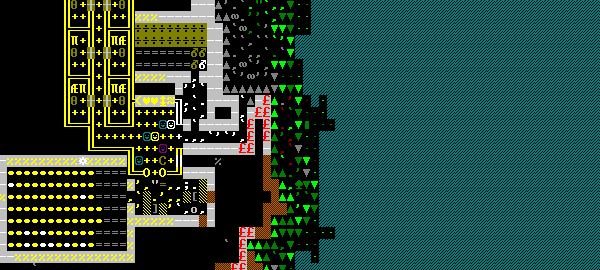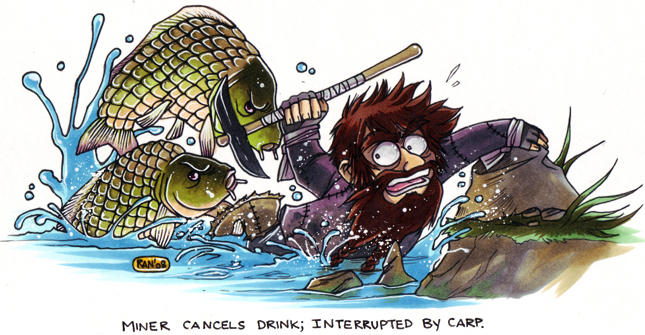As usual, work in progress. Images will be embedded in a second, after I get them put in the gallery.
About
Dwarf Fortress is an indie computer game in development by Bay12 Games, comprised of the brothers Tarn “ToadyOne” and Zach “ThreeToe” Adams. It is a sandbox city-building/roguelike game set in a procedurally generated fantasy world, which draws heavy inspiration from ancient mythology and other Tolkein-style settings[1].
The game is notable for its high level of complexity and depth of gameplay, in addition to being the inspiration for several other popular sandbox games, such as the widely successful indie game Minecraft.
The game is completely free to play, and has versions for Windows, Mac OS X, and Linux (i386). Development is supported by donations from the fanbase.
History
Dwarf Fortress started development in 2002, as a side project/sequel to the game Slaves to Armok: God of Blood, making Dwarf Fortress’s full title Slaves to Armok: God of Blood Chapter II: Dwarf Fortress. As time went on, the brothers began to focus more of their time on Dwarf Fortress, and in 2004 work on Armok ceased entirely. The first public version of Dwarf Fortress was 0.21.93.19a, released in 2006. The game has been in perpetual development since then, with new features being added constantly[2].
With the veritable mountain of features planned, Tarn has stated that development will probably take upwards of 20 years, and will continue even after this “completed version” is released.
Gameplay
A game of Dwarf Fortress starts with the creation of a world[3], which is randomly generated based upon certain general specifications the player chooses (such as world size, mineral occurrence, and length of pre-generated history). Each world has a set of civilizations, each with their own population, and the world generates years worth of historic background preceding the ‘present’ time that the user will play their session in. The default world specifications will generate a few civilizations for each major race (Dwarves, Humans, Elves, and Goblins), as well as 250 years of history, in a world large enough to house several thousand average-sized player fortresses without overlap.
Every bit of data in Dwarf Fortress is tracked, down to a nearly microscopic level. The only time anything is specifically spawned by the game is during world generation at year zero. Afterwards, every individual living creature is remembered and followed through its entire life (though with varying levels of detail based upon historic importance), tracking regional movement, injuries, reproduction and death. For sentient creatures such as Dwarves, their appearance, thoughts, and preferences are all calculated.
Dwarf Fortress has two main game types: Fortress Mode and Adventure Mode. In Fortress Mode[4], the player takes command of a group of Dwarves as they attempt to survive countless dangers in order to mine out the wealth of their chosen point of embark. The game progresses in real-time, with the ability to pause in order to make commands. Characteristics of Dwarven life include ubiquitous alcohol dependency, and a high predisposition towards manic depression.
Adventure Mode[5] plays like a very open-world Roguelike game, where the player is given control of a single character and can travel through the world, completing quests and exploring places such as fortresses they’ve previously built during past games in that same world.
Graphical Style
Everything in Dwarf Fortress is represented by a variation of ASCII[6] characters, called “code page 437”[7], and this fact has contributed heavily to the game’s steep learning curve. The player views the game from above, looking at a flat slice of the world at a certain elevation.
Similar to texture packs in Minecraft, Tilesets work to make the game look more modern, by replacing the ascii characters with more recognizable sprites.
Community
Due in part to the steep learning curve, and also because of the long but steady development cycle, Dwarf Fortress has gained a dedicated and enthusiastic fanbase of players, who generate quite a sizable amount of fan content. An official forum, founded in 2008, has about 50,000 members as of 2013.
Of particular note is Dwarf Fortress’s unique form of Let’s Play, most often called a Succession or Bloodline game. In these games, a group of players each take charge of a single fortress for a certain amount of time (usually a single in-game year), then pass the save onto the next person in line[8]. It is traditional during these games to write updates (often role-playing as a Dwarf living in the fort) based upon the player’s experiences during that year. In late 2006, a group of DF players on the Something Awful forums began Boatmurdered[9], which would later become the most well-known Succession game ever played, and put Dwarf Fortress on the map. References to the LP are still commonly seen within the community.
Fan Content
Interestingly enough, the Dwarf Fortress community produces a sizable amount of fanart for a game that has close to no actual visuals. This is most likely because, due to the highly minimalistic nature of the game’s graphics, players often exercise a high level of imagination to interpret the world. Sharing such concept art is, therefor, a popular pastime.
Notable Sub-Memes
Losing is Fun!
The game, and community’s, adopted motto[10]. As the saying goes, there is no final ending to the game, no way to “win” in the traditional sense. Thus, every fortress and adventurer will, eventually, die. Whether by Dwarf-eating river carp (which have been nerfed in recent versions, but used to be very dangerous and are still frequently referenced), Goblin invasions, or digging too deep and unleashing [spoiler redacted], every fortress ends in catastrophe.
Dwarf Fortress’s difficulty has become one of the most well-known aspects of the game, and the players have embraced this through their seeking of new and exciting ways to put Dwarves through any hardship imaginable. If it doesn’t involve gratuitous amounts of magma and complicated death traps, it isn’t “dwarven” enough.
FOR !!SCIENCE!!
Dwarf Fortress is a game of extreme complexity, with enough features to keep many players occupied for years. Thus, quite a lot of the possibilities the game’s deep physics engine provides are as of yet unknown or untested, even by the creators themselves. As a result, DF players take it upon themselves to perform all manner of ridiculous tricks and feats of engineering in the name of testing boundaries, or simply because it’s “the Dwarven way”[11].
Notable examples:
1.) Dwarven Daycare: A user by the name “Girlinhat” developed a system to trap infant dwarves (who are capable of feeding themselves) in an overcrowded room full of angry dogs, with Masterwork tier engravings and furniture. The dogs would attack the dwarf because of crowding, turning the child into a nihilistic killing machine over time. Players who still have a shred of morals in them tend to wonder if Goblin child-snatchers aren’t doing the kids a favor.
2.) Planepacked: By accidentally abusing a bug involving “burrows” (a method of restricting dwarves to certain areas), a dwarf in a “strange mood” created Planepacked, a limestone statue adorned with a ridiculous amount of items, seemingly in all . It is believed to have the entire history of the world engraved onto it. The feat remained a complete mystery for several months, until it was finally replicated and its cause documented, resulting in such artifacts as “Broiledprinces”.
3.) Project: F**k the World: A famous construction from the aforementioned Boatmurdered Succession game. Project: F**k the World was a cannon that, when activated, would flood the entire outside of the fortress in lava. It was used to kill monster elephants. And Goblins. And Elves. And a few humans, too.
4.) Dwarfputation: In early 2010, a forum user by the name of Jong successfully created the first entirely programmable digital computer within the game-space, proving that Dwarf Fortress is indeed Turing Complete. Since then, further experimentation and the minecart update have drastically improved on the capabilities of such devices.
LMAO 2CAT!!1
Within the Dwarf Fortress universe, cats can be used for pets, food, and clothing among other uses. They are also known for being incredibly virile, often reproducing massively if they find a home in your fort, often overrunning fortresses that do not keep their populations in check. The phrase is repeated by Dwarf Fortress fans, often mixed in as a caption to images, as a mocking representation of how a Dwarf Fortress fanatic would respond to the sight of a breeding pair[15].
Cacame Awemedinade the Immortal Onslaught
Cacame Awemedinade is an Elven NPC randomly generated by the game, who has achieved legendary status in the Dwarf Fortress fandom due to his position as an Elf so powerful that he became King of the Dwarves, and for slaying a dragon by wrestling it to death.
See Main Entry for more details.
See Also
Search Interest
External References
[1]Dwarf Fortress Wiki – About Dwarf Fortress
[2]New York Times – The Brilliance of Dwarf Fortress
[3]Dwarf Fortress Wiki – World Generation
[4]Dwarf Fortress Wiki – Fortress Mode
[5]Dwarf Fortress Wiki – Adventure Mode
[7]Wikipedia – Code Page 437
[8]TV Tropes – Succession Game
[9]LP Archive – Boatmurdered – Introduction
[10]Dwarf Fortress Wiki – Losing
[11]Dwarf Fortress Wiki – Stupid Dwarf Trick
[12]Dwarf Fortress Wiki – Planepacked
[13]Bay12 forums – Dwarven Computer
[14]Bay12 Forums – Dwarven… Child Care
[15]/jp/ Otaku Culture – Please Explain This Meme to Me



